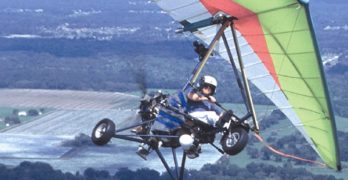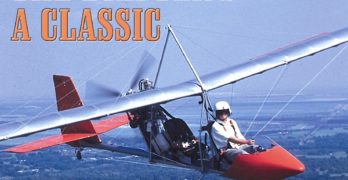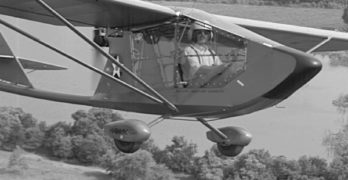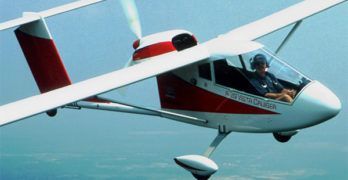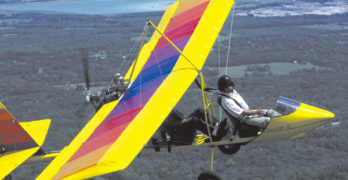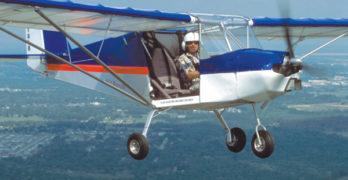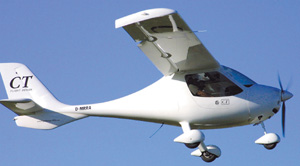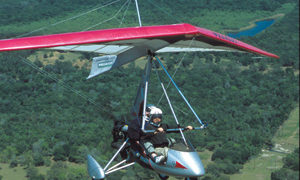Until recently, we heard little from South Africa. Under the country’s apartheid (racial segregation) rule of the past, South Africa disappeared off the radar so far as most Yankee pilots knew. Our government instituted economic sanctions so that few, if any, South African products appeared in America.
Apartheid is over, and with it the isolation of that southern hemisphere country and its people. In recent years, we’ve seen a growing number of products arrive from the way down under country. Perhaps you’re not surprised to hear that South African ultralight builders are also making a mark on American aviation. Welcome to the modern age of globalization.
No Pushy Peddler
You probably already know of Rob Rollison. He garnered attention in April ’95 by flying his Air-Bike from Indiana to Lakeland, Florida.1 The trip set no records – Ian Coristine, Dave Goulet and Don Zank flew 2-seat Challengers 2,400 miles (round trip) from Moline, Illinois to Lakeland a decade earlier – but in an open-cockpit ultralight, no doubt Rob’s 870-mile (each way) flight seemed longer.
Search Results for : Four stroke and ultralight
Not finding exactly what you expected? Try our advanced search option.
Select a manufacturer to go straight to all our content about that manufacturer.
Select an aircraft model to go straight to all our content about that model.
Super Drifter
The original Drifter was one of the ultralight industry’s flagship aircraft. Hatched by early entrepreneur Dennis Franklin, the Maxair Drifter enjoyed immense popularity. Several reasons exist for the Drifter’s popularity, and these were enough for Leza-Lockwood to offer a rebirth to the design.
Déjà Vu All Over Again
The Drifter is a tough design. The basic airframe consists of a lower boom tube that supports the pilot at the front and the large empennage at the rear with an engine midship. Because the separation is longer than some similar designs, the Drifter boasts a high level of stability that should please most pilots.
Secured to the boom by a series of triangulated tubing structures, the wing is classic Klaus Hill. This prolific designer from the early ’80s died in an unfortunate accident many years ago, but not before putting his indelible mark all over ultralight aviation. Klaus is directly responsible for the wings of the Weedhopper, Hummer, Humbug and SuperFloater.
Hawk Plus
CGS’ new Hawk Plus
As the year 2000 approaches, computer programmers may be sweating that Y2K bug we’ve all heard way too much about. Ultralight enthusiasts, on the other hand, will be celebrating the completion of two full decades as a member of the aviation community. Throughout the 1980s and 1990s, a lot has happened.
This newest community of pilots and designers learned a great deal. Accidents are far lower than in the “old” days, and equipment is far better. Specifically, ultralight aircraft designs are the best we’ve seen, with many reliable brands offering airworthy sport-flying machines.
Buyers of ultralights include those lightweight enthusiasts who enjoy Part 103’s freedom from FAA licenses, registration or certification. That’s why ultralights can be bought for $10,000 to $15,000, and you don’t need an FAA ticket to fly one legally. That fact practically assures that ultralights will stay on the radar of many aging baby-boomer pilots.
Aeroprakt’s A-20 Vista Cruiser
UPDATE–November 2008: According to FPNA, an American company with a business relationship to A-20 producer Aeroprakt, the A-20 has been discontinued. Please contact FPNA for more information (contact info at end of article).
Two summers ago Americans saw a new aircraft from a Ukrainian company called Aeroprakt as U.S. importer Spectrum Aircraft brought in the A-22 Valor. It would be only the first in a fleet of new microlights.
Later another model from Aeroprakt appeared. In fact, the Vista series comprises 5 models, all variations on a basic theme that is nothing like the Valor. At present, the Ukraine enterprise has no less than nine models including the Valor, Vista, Cruiser, V-STOL, V-SS, Vulcan, Vulcan-SS, Victor single engine, Victor twin, and Viking. Four of this series are twin-engine aircraft, none are alike, and one is a 4-seater. By any measurement, this is quite an accomplishment from a company less than 10 years old and rising from the ashes of the failed Communist empire.
Super Drifter XL with Rotax 912
Considered by many to be a workhorse, the Super Drifter XL shows refinement and features that make it seem like a “luxury ultralight.” Leza AirCam, the newly renamed producer of this venerable ultralight, has equipped the top-of-the-line model with nearly every option in their price list. Conclusion: While it will cost you a bundle, you should be satisfied with this ultralight for many years.
How is this Super Drifter XL different from the Super Drifter that I evaluated almost 3 years ago? According to Denny Franklin – yes, that same icon of the Maxair days when the Drifter was a youngster – the XL is a significant redesign of the original Super Drifter 912 flown in 1998.1 It has seen numerous changes to make the veteran design work better with the big 80-hp Rotax 912 situated at the rear of the wing.
What’s New With the Super Drifter XL?
The Super Drifter XL has an extended fuselage – meaning the boom tube and its fuselage “pan” – to position the front seat 5 inches further forward.
French Quick-Build 2 Seater
One of the most popular club planes in France is widely used by instructors in that country. Now we welcome the Sky Ranger to North American skies.
In France, as with much of Europe, many ultralights are owned by aero clubs which frequently manage recreational airfields throughout the continent. Run a little differently in each location, they provide common ways for average pilots to fly and for newcomers to be introduced to flight. Virtually all aero clubs provide instruction, often through associated flight schools. Clubs also own and maintain aircraft – lots of them. This has worked especially well with sailplanes; Europe has more than twice as many sailplanes as the United States and several times the pilot population. Ultralight enthusiasts have followed this example.
The Sky Ranger arrived in the mid-1990s at French ultralight aero clubs that dot the landscape, and has done very well. U.S. importer Sabre Aircraft says, “It’s the most popular ultralight in France, especially with the flight schools.” In more than just 6 years, the company claims deliveries of about 500 aircraft.
Fixed -Wing or Flex-Wing
This month I wrote a pilot’s report about two widely different aircraft, both of which are imported by Rollison Airplane Company. Here’s how I handled it.
Every “Ultralight Flying! Pilot’s Report” has common elements: a main article, photos and photo legends, specifications, and our exclusive “Report Card.” Because the two subject flying machines are so different this month, I’ve prepared a “Report Card” for each aircraft. I did the same for specifications as the standard and optional features obviously differ too much for grouping.
In the main article, I take alternate looks at the two flying machines as a way to observe their differences, but further how they each have their benefits.
I also selected more photos – even though Ultralight Flying! reports regularly present many photos of ultralights being reviewed as readers often say that photos are a key informative element.
Because reviewing two different craft makes for a longer pilot report, I’ve somewhat abbreviated both the main article and the twin “Report Cards.”
Quite a few general aviation pilots recognize that ultralights offer a different way to fly| and that’s precisely what they like about them.
Flex-Wing or Fixed Wing
This month I wrote a pilot’s report about two widely different aircraft, both of which are imported by Rollison Airplane Company. Here’s how I handled it.
Every “Ultralight Flying! Pilot’s Report” has common elements: a main article, photos and photo legends, specifications, and our exclusive “Report Card.” Because the two subject flying machines are so different this month, I’ve prepared a “Report Card” for each aircraft. I did the same for specifications as the standard and optional features obviously differ too much for grouping.
In the main article, I take alternate looks at the two flying machines as a way to observe their differences, but further how they each have their benefits.
I also selected more photos – even though Ultralight Flying! reports regularly present many photos of ultralights being reviewed as readers often say that photos are a key informative element.
Because reviewing two different craft makes for a longer pilot report, I’ve somewhat abbreviated both the main article and the twin “Report Cards.”
Quite a few general aviation pilots recognize that ultralights offer a different way to fly| and that’s precisely what they like about them.
Titan Tornado
An Experimental ‘fighter jet’ that any pilot could love That vast majority of general aviation pilots who won’t even think about building their own plane has missed quite a revolution.
The FAA says approximately 25,000 aircraft are registered as Experimentals. That’s 15% of the GA fleet.
Building isn’t what it used to be. You no longer need to master the skill of reading engineering prints (plans), nor must you search high and low for parts.
These days, most registered Experimental aircraft are built from kits. Many are well-fabricated packages that can be assembled in just a few hundred hours. That can mean as little as two or three hours a night, two to three days a week, for about a half-year. Not a bad investment for a truly unique airplane.
One sport pilot who enjoys flying his creations is Minnesota resident Al Reay. For Reay, building is a means to an end.
Super Magnum
The Super Magnum packs an 80-horse four-stroke Verner Some general aviation pilots are put off by ultralights; for others they’re great fun.
If you’re the type who likes the idea of ultralight flight but you don’t trust the common two-stroke engines, then Sport Flight’s Super Magnum kit-built aircraft with the Verner engine may be what you’re looking for.
JOIN THE FAMILY
For nearly a decade, Sport Flight Aviation has produced the Talon XP two-seater and the Magnum single-seater. In 1998 the company added the Super Magnum, a one-place airplane that features a substantial 80-horsepower engine from the Czech Republic.
The Verner SVS-1400 engine was brought to the United States by Milan Stavenik in the mid-1990s. Milan lost his life in an accident unrelated to the Verner, but development of the engine has continued under Sport Flight Aviation owner Roger Bitton.
In addition to the Verner, the new HKS 700E, imported from Japan by Hpower, is enjoying a good reception.


